The Sternum or Breast Bone is a long flat bone, which is enlarged about 7 cm long. It is located in the anterior median part of the chest wall.
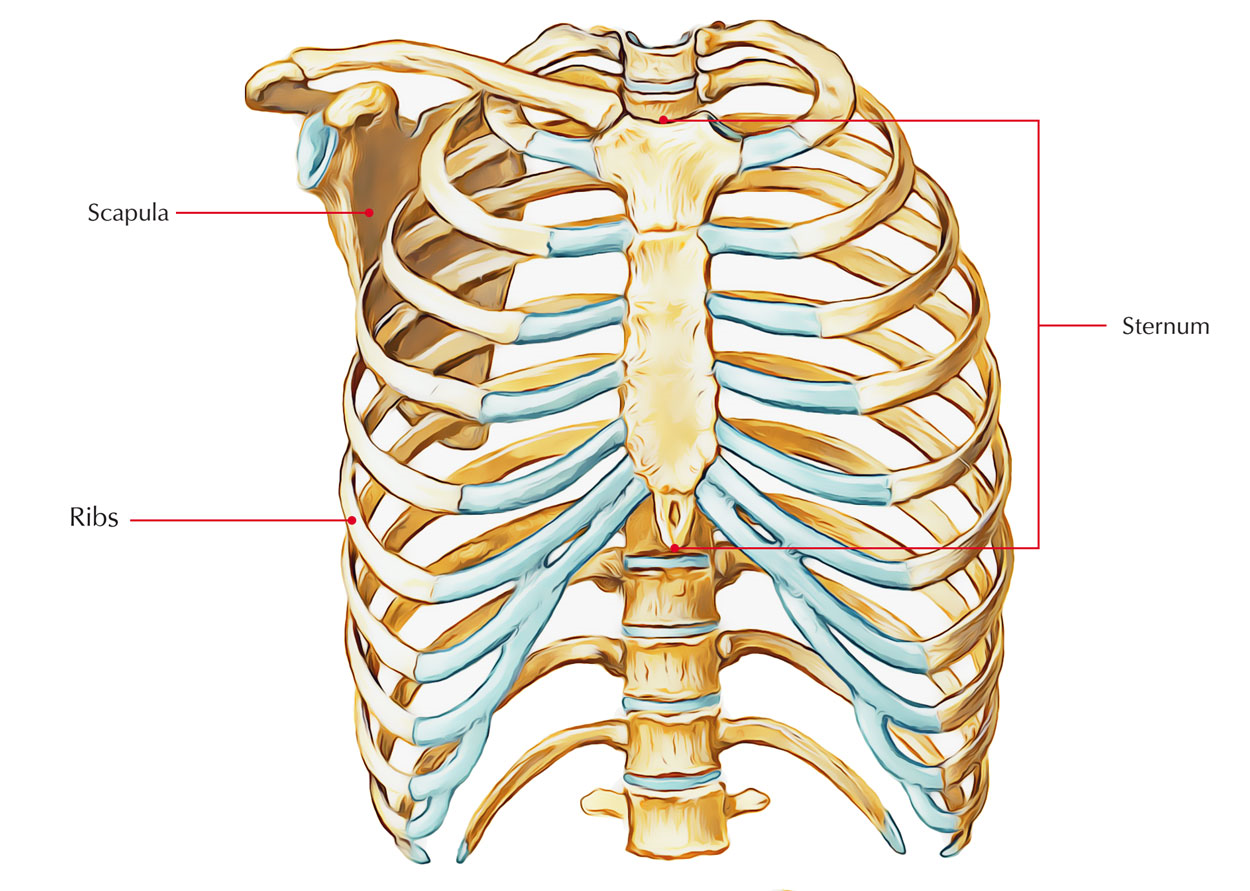
Location of Sternum
Parts
The sternum is composed of the following 3 parts:
- Upper part, the manubrium sterni/episternum
- Middle part, the body/mesosternum
- Lower part, the xiphoid process/metasternum
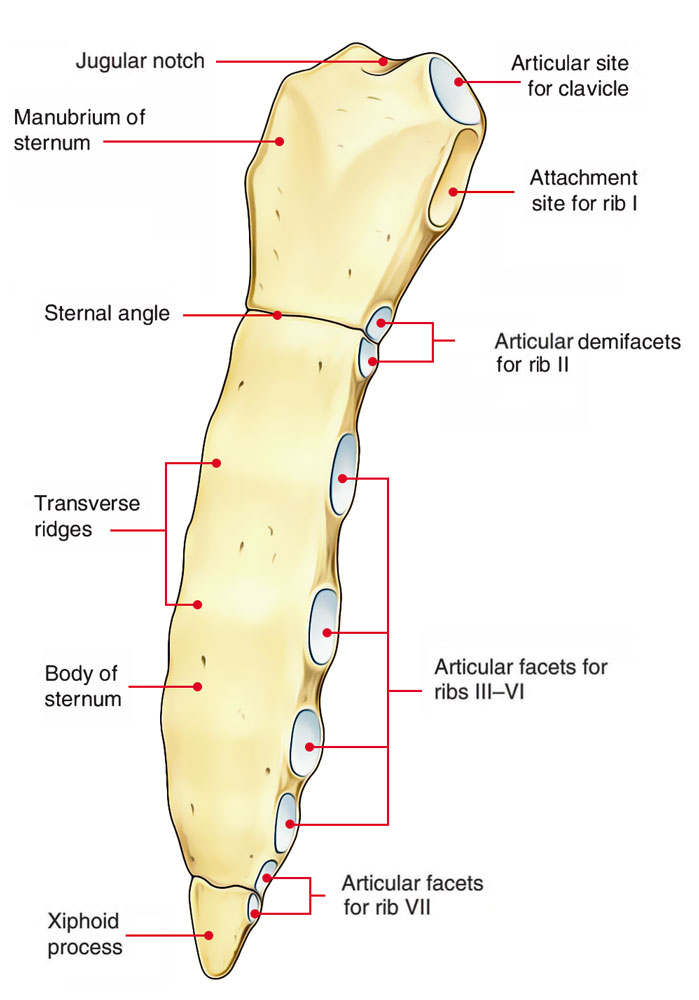
Parts of Sternum
The shape of the sternum somewhat resembles to a small sword or a dagger. Sternum comprises of 3 parts, namely – manubrium, body, and xiphoid process that respectively acts to the handle, blade, and point of the sword.
The upper part of sternum is broad and thick, on the other hand its lower part is thin and pointed. Its anterior surface is somewhat rough and convex, while its posterior surface is smooth and somewhat concave.
The manubrium and body of sternum is located with an angle of 163° to every other, which grows somewhat during inspiration and falls during expiration. The angle between long axis of manubrium and long axis of body of sternum is about 17 °.
Anatomical Position of Sternum
In anatomical position, the sternum as a whole is pointed downwards and inclined somewhat forward with it’s rough convex surface facing anteriorly. It’s broad end is directed upwards and lower pointed end is directed downwards.
Features and Attachments of Sternum
Manubrium (Episternum)
The Manubrium of sternum is almost quadrilateral in shape. It is located opposite to the 3rd and fourth thoracic vertebrae.
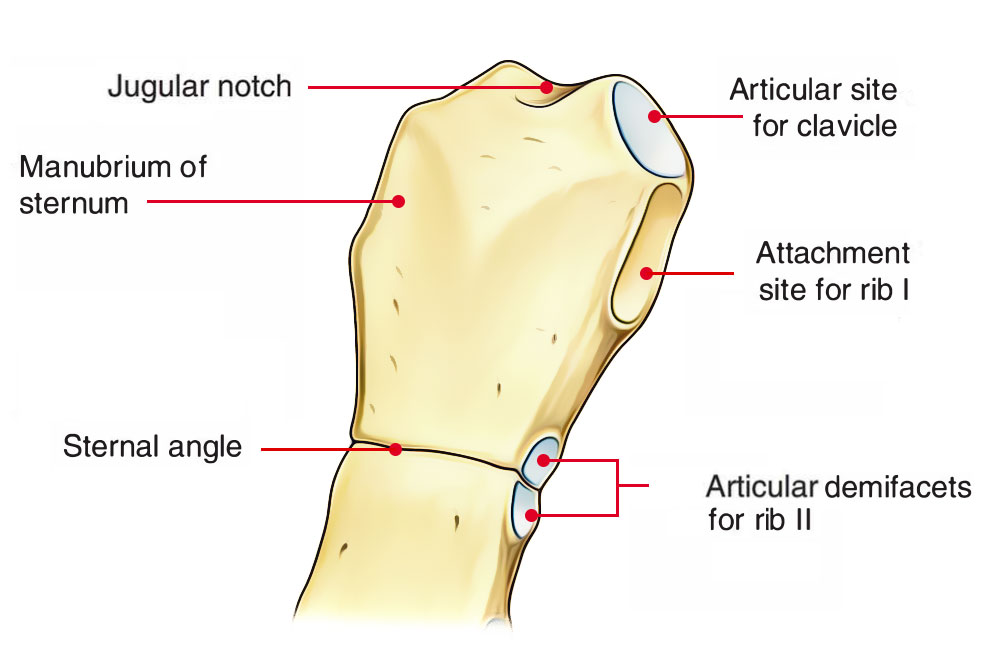
Sternum – Manubrium
It’s the thickest and most powerful part of the sternum and presents two surfaces – anterior and posterior and four edges – superior, inferior, and lateral (left and right) these features are as follows:
- Anterior surface on every side gives connection to the sternal head of sternocleidomastoid and pectoralis major muscles and Posterior surface is smooth and creates anterior boundary of superior mediastinum
- On every side, it gives connection to 2 muscles: Sternohyoid at the level of clavicular notch, and Sternothyroid at the level of facet for 1st costal cartilage
- Lower half is associated with arch of aorta and Upper half is associated with three branches of the arch of aorta, viz. brachiocephalic artery, left common carotid artery, left subclavian artery, and left brachiocephalic vein
- Upper border is thick, rounded, and concave. It presents a notch termed suprasternal notch or jugular notch and gives connection to the interclavicular ligament. Clavicular notch on each side of suprasternal notch articulates with the clavicle to create sternoclavicular joint.
- Lateral border presents 2 articular facets: Upper facet articulates with the 1st costal cartilage to create primary cartilaginous joint. and Lower demifacet together with other demifacet in the body of sternum articulates with the 2nd costal cartilage.
- Lower border articulates with all the upper end of the body of sternum to create secondary cartilaginous joint named manubriosternal joint. The manubrium makes a little angle with all the body at this junction referred to as sternal angle or angle of Louis. It is recognized by the presence of a transverse ridge on the anterior aspect of the sternum.
Body (Mesosternum)
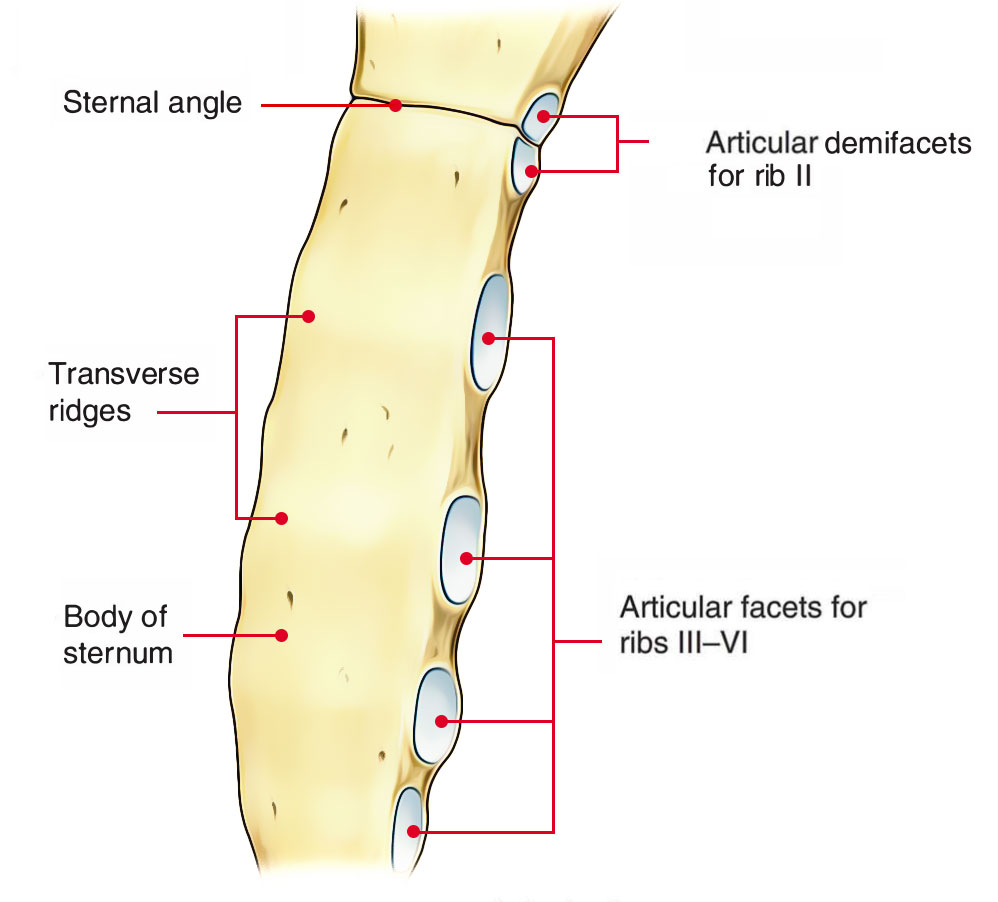
Sternum body
The features of the body of the sternum are as follows:
- It’s longer, narrower, and thinner compared to the manubrium and is widest at its lower end.
- Its upper end articulates with the manubrium in the sternal angle to create manubrio sternal joint and lower end articulates with the xiphoid process to create primary cartilaginous xiphisternal joint.
- Its anterior surface presents 3 dim transverse ridges signaling the lines of fusion of 4 small sections referred to as sternebrae. The anterior surface on every side gives origin to the pectoralis major muscle.
- Its posterior surface is smooth and somewhat concave.
- Lower part of posterior surface gives origin to sternocostalis muscle.
- On the right side of median plane, posterior surface is linked to pleura, which divides it from the lung.
- On the left side of median plane, upper half of the body is linked to the pleura and lower half to the pericardium (naked area of the pericardium).
- Its lateral border articulates with the 2nd-7th costal cartilages (to create synovial joints. Strictly speaking, 2nd costal cartilage articulates at the side of manubriosternal junction and 7th costal cartilage articulates at the xiphisternal junction).
Xiphoid Process (Metasternum)
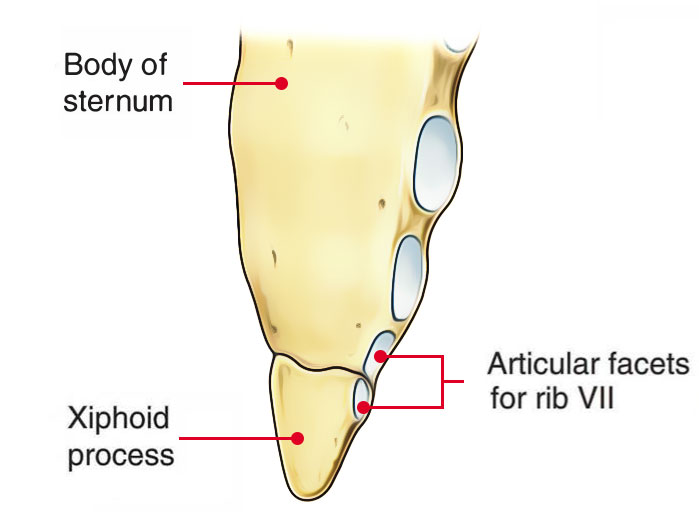
Sternum – Metasternum
The Xiphoid Process of Sternum has the following features:
- It’s the lowest and smallest part of the sternum.
- It varies considerably in size and shape.
- It might be bifid or perforated.
- Its anterior surface gives insertion to the medial fibres of the rectus abdominis.
- Its posterior surface gives origin to the sternal fibres of the diaphragm.
- Its tip gives connection to the upper end of linea alba.
Muscles Connected on the Posterior and Anterior surfaces of Sternum are summarized below:
| Muscle attached on the anterior surface of the sternum | Muscles attached on the posterior surface of the sternum |
|---|---|
| Sternal head of sternocleidomastoid | Sternohyoid |
| Pectoralis major | Sternocostalis |
| Rectus abdominis | Diaphragm (sternal fibres) |
Features of interest at the sternal angle: Sternal angle can be felt as a transverse ridge on the sternum about 5 cm below the suprasternal notch. The sternal angle is a significant surface bony landmark for several anatomical occasions exact this level. These are:
- Second costal cartilage articulates, on each side, with the sternum at this level, therefore this level is utilized for counting the ribs.
- It is located at the level of intervertebral disc between T4 and T5 vertebrae.
- Horizontal plane going through this level divides superior mediastinum from inferior mediastinum.
- Ascending aorta finishes at this level.
- Arch of aorta starts and finishes at this level.
- Descending aorta starts at this level.
- Trachea bifurcates into left and right main bronchi at this level.
- Pulmonary trunk splits into left and right pulmonary arteries at this level.
- Upper border of heart is located at this level.
- Azygos vein arches over the root of right lung to finish in the superior vena cava.
Ossification
The sternum grows from 2 vertical cartilaginous plates (sternal plates), which fuse in the midline.
The sternum ossifies from 6 double centers, viz.
- 1 for manubrium
- 4 for body
- 1 for xiphoid process
Appearance
The facilities seem in descending sequence for unique parts of sternum as follows:.
- Manubrium: 5th month
- Body
First sternebra: 6th month.
Second sternebra: 7th month.
Third sternebra: 8th month.
Fourth sternebra: 9th month. - Xiphoid process: 3rd year
Clinical Relevance
Sternal Puncture
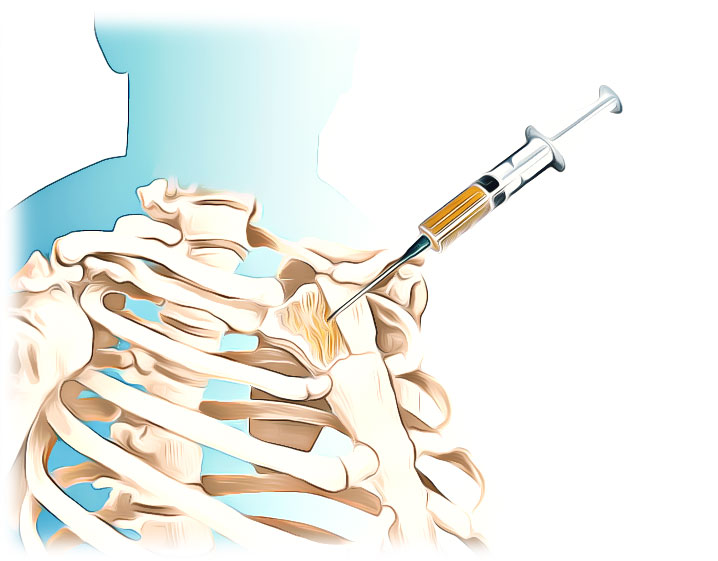
Sternum – Sternal Puncture
Manubrium sterni is the favorite site for bone marrow aspiration because it’s subcutaneous and easily approachable. The bone marrow sample is obligatory for hematological evaluation. A thick needle is inserted into the upper part of manubrium to prevent injury to arch of aorta which is located behind the lower part. Sternal puncture isn’t advisable in kids because in them the plates of compact bone of sternum are extremely thin and if needle goes through and via the manubrium it’ll damage the arch of aorta and its branches, resulting in lethal hemorrhage.
Mid-Sternotomy
To get access to the mediastinum for surgical operations on heart and great blood vessels, the sternum is frequently split in the median plane named midsternotomy.
Funnel Chest (Pectus Excavatum)
It’s an abnormal shape of thoracic cage where chest is compressed anteroposteriorly and sternum is pushed backwards by the overgrowth of the ribs and might compress the heart.
Pigeon Chest (Pectus Carinatum)
It’s an abnormal shape of thoracic cage where chest is compressed from side to side and sternum projects forward and downward like a keel of a boat.
Sternal Fracture
It’s common in automobile accidents; example, when the motorist’s chest is hit against the steering wheel, the sternum is frequently fractured at the sternal angle. The backward displacement of fractured fragments may damage aorta, heart, or liver and cause serious bleeding which may prove lethal.
Sternal Foramen and Cleft Sternum
The two sternal plates fuse in caudocranial direction. Occasionally sternebrae neglect to fuse in the midline, as a consequence defect happens in the body of sternum in the structure of sternal foramen or cleft sternum. The cleft sternum is frequently related to ectopia cordis.
Test Your Knowledge
Sternum Quiz

 (60 votes, average: 4.85 out of 5)
(60 votes, average: 4.85 out of 5)